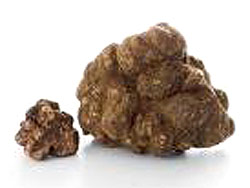At this time of year, the white truffle rules. Its elusive but penetrating scent, redolent of earth, wood and a vague hint of garlic, kicks dishes into the stratosphere.
The scent is the thing and the means by which the uncultivated white truffle, native to the Italian hill country south of Alba, is hunted. I recently had the pleasure of joining a truffle-hunting expedition led by master truffle-hunter, Enrico Bertolino, a tall, sharp-featured woodsman, and his canine companion, Stella, a graduate of the University of Truffle Hounds at nearby Roddi. Dogs, not pigs, sniff out white truffles, a tradition as old as the nearby hills and still the most effective way to hunt them: pigs often consume the treasure before people can intervene.

As we drove to the hunting range, Bertolino discussed the current truffle season. Rain in June, he said, was the best promise of a bountiful crop. This year it had rained late, in September, and not enough. “When the earth is dry,” Bertolino said sadly, “the truffles hide.”
Bertolino’s grandfather and uncle had also been truffle hunters, but the breed is dying out. In the hill country, there were now only a half dozen hunters and the environment works against them. “Chemicals in the ground," said Bertolino. “Pollution and smog. Progress will kill us all.”
Truffle hunger is, however, constant. In Alba white truffles are ogled in shops where they’re displayed under glass, commanding up to $6,000 per pound. Bertolino sells all his truffles to one Alba purveyor, Tartuffi Morra, which pays him by the gram. His prize sell was a 435-gram white truffle, but, he quickly adds, there’s no correlation between size and quality. Nor is scent a guide. “Not all truffles smell alike,” he says. “And even if you know truffles, you can’t always tell the good from the bad.”

Bertolino, happily chain-smoking, brings the car to a halt about six miles outside Alba. He liberates Stella from the car trunk in which she’s traveled contentedly and we descend into a gully. The closeness of the hunting range to everyday traffic is surprising. “Vai, vai,” Bertolino says to Stella, “go”—and off she bounds, instantly sniffing the earth near oaks, poplars and willows with whose roots white truffles grow symbiotically.
Bertolino alternately encourages and admonishes her, periodically making a quacking noise to attract her attention. “Go here,” he tells her, “no, down there! Look, please, there!”
Stella stops suddenly and begins to dig. Bertolino brushes her aside. Using a spade-like tool called a sapin, he digs in the hole Stella has made, excavating a wrinkled darkish something the size of a large marble—an early winter truffle, he says. “Smell it,” he tells me. It’s aromatic, but has nothing of the rich scent of its white counterpart. It’s also hollow. “Immature,” Bertolino says, tossing it aside.
We walk deeper into the woods. “Vai su,” Enrico tells Stella, “go up.” But she seems to have found something. Bertolino digs but comes up empty-handed. Again, Stella is told to hunt, and minutes later and further along, begins pawing at the base of an oak. Bertolino hollows out the clawed earth and then flourishes something—a golf ball-size white truffle. “About 30 grams,” he says nonchalantly. I try not to show too much excitement. The truffle’s perfume instantly fills the air.
Bertolino pockets the truffle and refills the hole. This allows the truffle to regrow and also conceals his efforts from other truffle hunters. He gives Stella her reward, a piece of bread, which she enthusiastically devours.
Returning to Alba in the car, I ask a final question: can truffles, so marvelous to eat, be good for you too?
“Some say they are,” says Bertolino. “They also say they’re an aphrodisiac. When I was younger, I could eat one or two at a time. Now they’re more rare than ever, so we must live in hope, all of us, of finding more.”
Homepage, top photo: whitetruffleaction.com